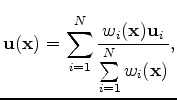 |
 |
 |
 | Earthquake extraction and correlation energy at Long Beach, California seismic survey |  |
![[pdf]](icons/pdf.png) |
Next: Earthquake Snapshots
Up: Earthquake Recordings
Previous: Earthquake Recordings
To create these snapshots, we implemented a normalized inverse distance weighting interpolation scheme. First, we normalized the amplitudes of the recordings because we did not want anomalously high amplitudes to dominate the interpolation results. Second, we created a  by
by  grid of rectangular cells that overlapped with the
grid of rectangular cells that overlapped with the  km north-south by
km north-south by  km east-west region containing the array. To determine which stations would be used for interpolating the response at a given cell, we implemented nearest-neighbor binning.
km east-west region containing the array. To determine which stations would be used for interpolating the response at a given cell, we implemented nearest-neighbor binning.
Rather than average the recordings from each station for a given cell, we apply a weight to the relevant recordings for a given cell and then sum the recordings. The weight is the normalized inverse of the distance between the location of the recording and the center of the cell, having the form
 |
(1) |
where
 |
(2) |
 is the interpolated recording at cell
is the interpolated recording at cell
 ,
,
 is the weight applied to station
is the weight applied to station  when interpolating for cell
when interpolating for cell
 ,
,
 is the recording at station
is the recording at station  , and
, and
 is the distance between the center of the cell
is the distance between the center of the cell
 and the relevant station at location
and the relevant station at location
 . This interpolation scheme weights recordings that are closer to the center of the cell more so than those recordings that are closer to the edges of the cell. The normalization of the weights by the sum of the weights ensures that the amplitudes from cell to cell are relatively similar, particularly because the amplitudes at each station were first normalized.
. This interpolation scheme weights recordings that are closer to the center of the cell more so than those recordings that are closer to the edges of the cell. The normalization of the weights by the sum of the weights ensures that the amplitudes from cell to cell are relatively similar, particularly because the amplitudes at each station were first normalized.
 |
 |
 |
 | Earthquake extraction and correlation energy at Long Beach, California seismic survey |  |
![[pdf]](icons/pdf.png) |
Next: Earthquake Snapshots
Up: Earthquake Recordings
Previous: Earthquake Recordings
2012-10-29
 by
by  grid of rectangular cells that overlapped with the
grid of rectangular cells that overlapped with the  km north-south by
km north-south by  km east-west region containing the array. To determine which stations would be used for interpolating the response at a given cell, we implemented nearest-neighbor binning.
km east-west region containing the array. To determine which stations would be used for interpolating the response at a given cell, we implemented nearest-neighbor binning.


 is the interpolated recording at cell
is the interpolated recording at cell
 ,
,
 is the weight applied to station
is the weight applied to station  when interpolating for cell
when interpolating for cell
 ,
,
 is the recording at station
is the recording at station  , and
, and
 is the distance between the center of the cell
is the distance between the center of the cell
 and the relevant station at location
and the relevant station at location
 . This interpolation scheme weights recordings that are closer to the center of the cell more so than those recordings that are closer to the edges of the cell. The normalization of the weights by the sum of the weights ensures that the amplitudes from cell to cell are relatively similar, particularly because the amplitudes at each station were first normalized.
. This interpolation scheme weights recordings that are closer to the center of the cell more so than those recordings that are closer to the edges of the cell. The normalization of the weights by the sum of the weights ensures that the amplitudes from cell to cell are relatively similar, particularly because the amplitudes at each station were first normalized.